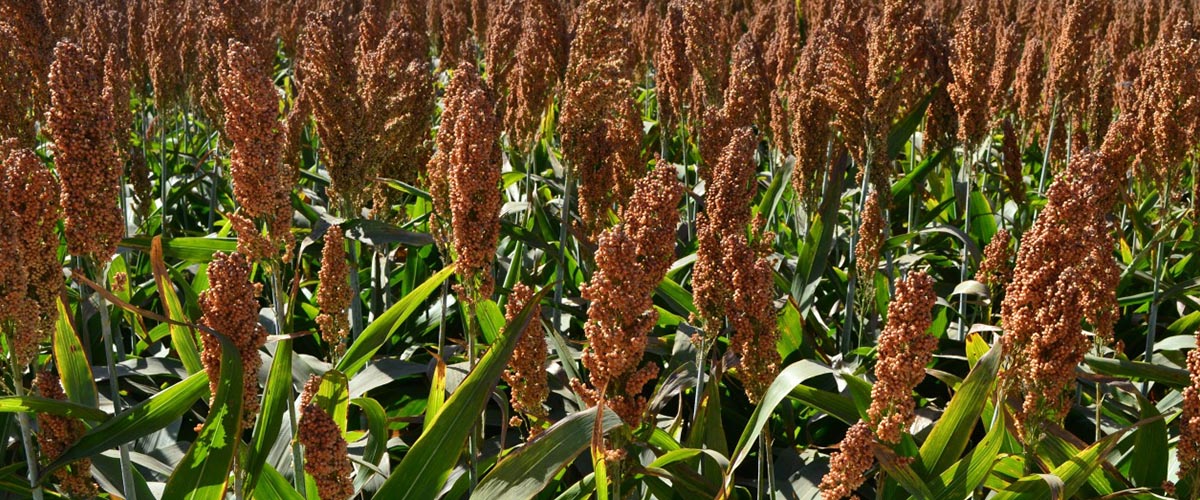Ecological requirements for sorghum production

Ecological requirements for sorghum production
- Sorghum is adapted to a wide range of ecological conditions, surviving in the tropical, sub-tropical, and temperate regions of the world.
- It is planted in areas considered to be too dry and hot for other cereals to survive because of its tolerance to drought and heat stress.
- The adaptability enables sorghum to grow from sea level to above 2000m above sea level.
- However, sorghum performs well under optimum conditions of deep well-drained fertile soils, moderate to high relatively stable rainfall distribution most of which should be received during the vegetative phase and temperate to warm weather (20-30°C).
- These conditions result in yield potential of 3000-5000Kgha-1 if improved cultivars are used.
- Unfortunately, the high yield potential is not realized in Uganda because farmers grow low yield potential sorghum under low-input semi-arid conditions
Soils
- Sorghum grows well in a wide range of soils except in waterlogged places.
- It grows best on well-drained fertile soils with a moderate amount of organic matter at soil pH values between 6 and 7.5.
- At this pH range, most nutrients are more easily assimilated by the plant roots.
- It has some tolerance to salt and aluminum toxicity.
- However, in Uganda sorghum is mainly grown on low potential, shallow soils with high clay-loam or sandy-loam texture.
- The soils are deficient in nitrogen and phosphorous and mainly acidic.
- Thus there is a need to ameliorate the soils by liming to lower the acidity in order to attain optimum productivity of sorghum.
Temperature
- Sorghum is a warm-weather crop, which requires high temperatures for good germination and growth.
- Low temperatures may prevent the successful production of grain sorghum.
- Soil temperature at planting time is critical for grain sorghum.
- The recommended temperature for germination is 17-18°C while lower temperature prolongs germination.
- The best time to plant is when there is sufficient moisture in the soil.
- Temperature is important for the normal growth and development of sorghum after germination.
- A temperature of 27 to 30°C is required for optimum growth and development through the crop can still survive below 21 °C, without a dramatic effect on growth and yield.
- Fortunately, the temperature in most sorghum growing areas of Uganda is above 200C except in the southwestern regions with <200C, indicating that temperature is not a constraint to production.
Day length
- Sorghum is a short-day plant requiring long night hours before the reproductive stage.
- Thus varieties introduced from the temperate regions into tropical regions fail to develop seed because of photoperiodism.
- The optimum photoperiod, which will induce flower formation, is between 10 and 11 hours.
- Photoperiods longer than 12 hours stimulate vegetative growth.
- Sorghum plants are most sensitive to photoperiod during flower initiation.
- However, most of the improved varieties developed for Uganda’s conditions are not sensitive to photoperiodism and can thus perform well in almost all parts of Uganda.
Rainfall
- Sorghum is known to be drought tolerant and can do well in areas with little rainfall but performs better in conditions where water is available.
- It can be grown under hot and dry conditions with its roots penetrating a greater volume of soil to obtain moisture.
- Water requirement increases and reaches its peak during flowering.
- In Uganda, sorghum grows under fluctuating rainfall conditions of approximately 82-130 mm per month.
- Some varieties have physiological mechanisms, such as stay green, for avoiding the effects of droughts.
- Stay green trait promotes adaptation to drought by producing waxy leaves and stems that protect the plant form desiccation.
- The leaves fold up and stomata close rapidly to limit water loss during warm and dry conditions.
- The stay green mechanism involves reducing tillering, increasing the size of lower leaves and constraining the size of the upper leaves and decreasing the number of leaves per culm.
- This results in reduced pre-flowering water demand, thereby increasing water availability during grain filling and, ultimately, grain yield.
- Sorghum also has the ability to remain in a virtually dormant stage and resume growth as soon as conditions become favorable.
- Even though the main stem can die, side shoots can develop and form seed when the water supply improves.



